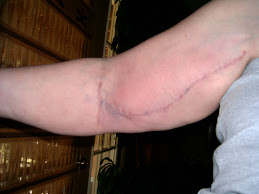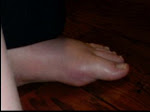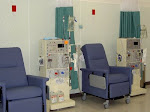This first illustration shows the catherter which is a temporary solution to an emergency situation.

The AV fistula access
The arm access is an AV fistula. An AV fistula is the gold standard for vascular access for hemodialysis and is associated with the lowest failure and complication rates when compared with other forms of vascular access.

I have been amazed at the lack of information by the general public about dialysis. True, I am extra curious about things and never cease to love learning. I like to know what things are and how things work and why. True, there are some things that I care absolutely nothing about, like most politics or the price of eggs in China. But things that are an everyday part of life, I usually find very interesting, at least to the degree that I have a pretty good understanding of it.
I have yet to come across anyone who know anything about dialysis. Most people associate dialysis with the external access that is used in emergency situations. So, here is my feeble attempt at educating the world, as if the entire world will pass through the portals of my humble blog.
The above picture is the kind of access I have except that it is in my upper arm. It is called an AV fistula. A wealth of clinical evidence confirms that the arteriovenous (AV) fistula is the safest and most effective form of vascular access in hemodialysis. Yet nationwide, only 30% of patients with end-stage renal disease (ESRD) receive a fistula as their permanent access for hemodialysis. “A fistula is most commonly created using the radial artery and vein, though it can also be created in the upper arm using the brachial artery.
An AV fistula requires advance planning because a fistula takes a while after surgery to develop But a properly formed fistula is less likely than other kinds of vascular accesses to form clots or become infected. Also, fistulas tend to last many years, longer than any other kind of vascular access.
A surgeon creates an AV fistula by connecting an artery directly to a vein, usually in the forearm. Connecting the artery to the vein causes more blood to flow into the vein. As a result, the vein grows larger and stronger, making repeated insertions for hemodialysis treatments easier.
Arteriovenous Graft
If you have small veins that won't develop properly into a fistula, you can get a vascular access that uses a synthetic tube implanted under the skin in your arm. The tube becomes an artificial vein that can be used repeatedly for needle placement and blood access during hemodialysis. A graft doesn't need to develop as a fistula does, so it can be used sooner after placement, often within 2 or 3 weeks.
Compared with fistulas, grafts tend to have more problems with clotting or infection and need replacement sooner, but a well-cared-for graft can last for several years.
There are other options that I won't explore here. There are plenty of sites to find all you might want to know. I hope this might clear up any confusion you might have about dialysis.









No comments:
Post a Comment